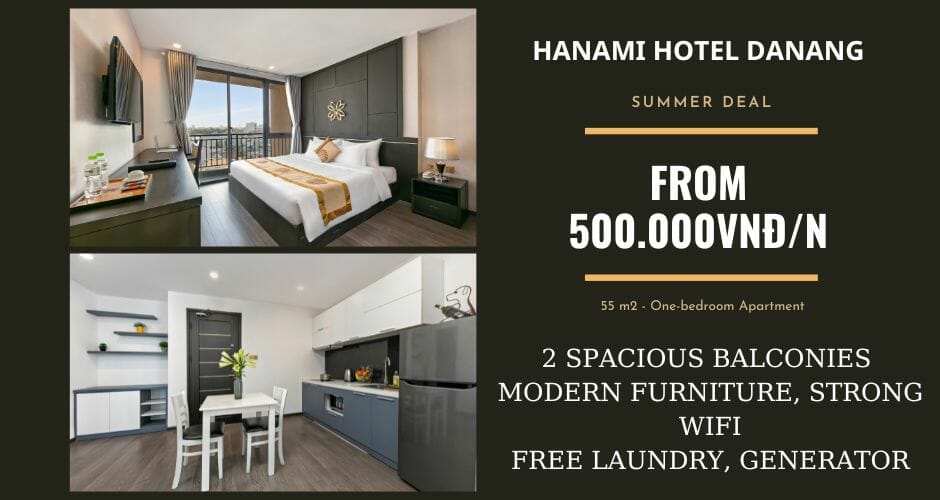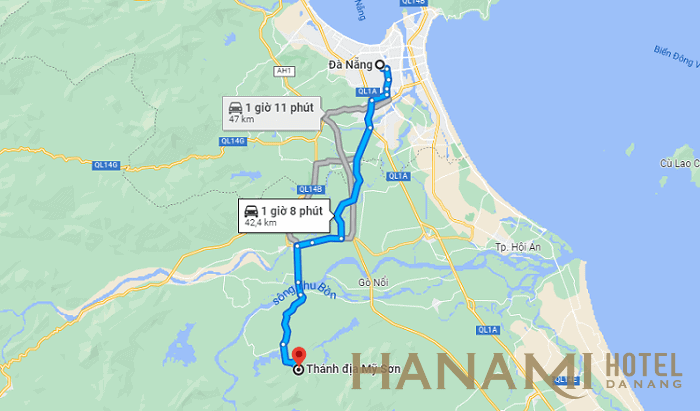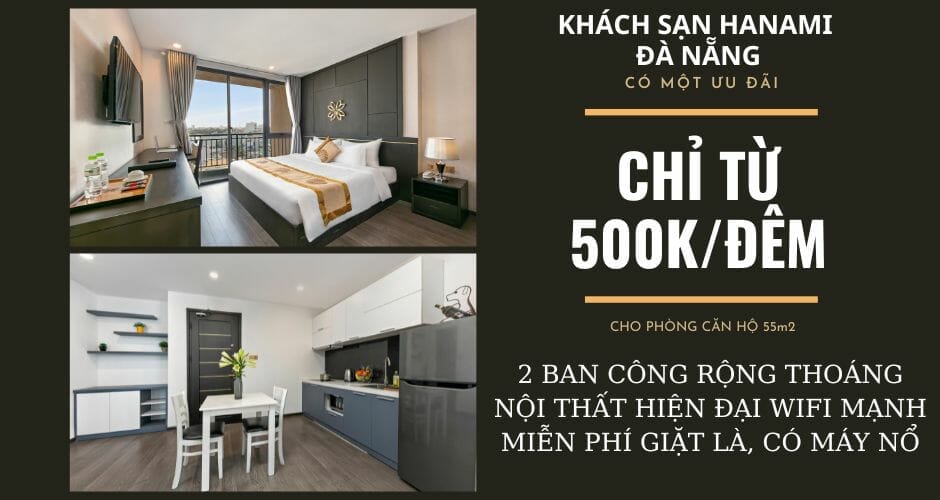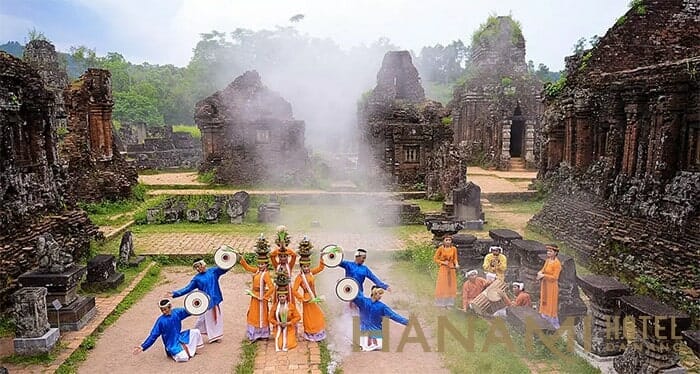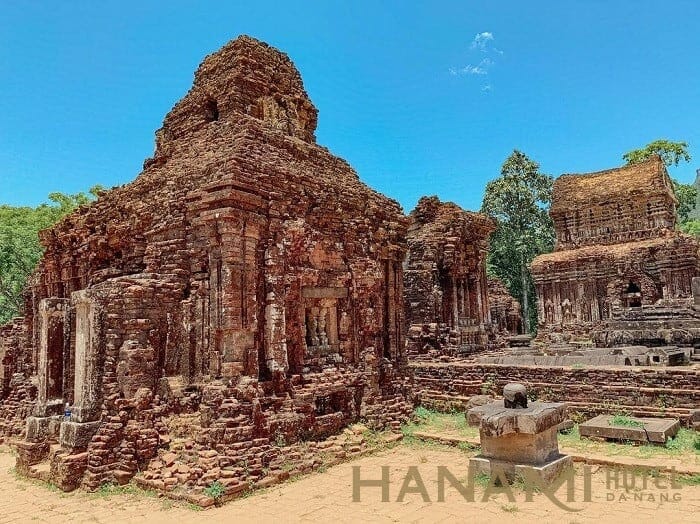Both domestic and international tourists are no longer surprised by the moniker “My Son Sanctuary,” especially those who enjoy learning about old cultural artifacts. The complex of beautiful red-brick temples and towers at Hoi An provides insight into the Champa civilization’s architectural temples, crystallized in long-lasting material relics. My Son Sanctuary reveals historical, cultural, architectural, and artistic values that have evolved over a nine-century span. Follow Hanami Hotel Danang’s article: “My Son Sanctuary: Ruins from the Champa Empire,” to find out more!
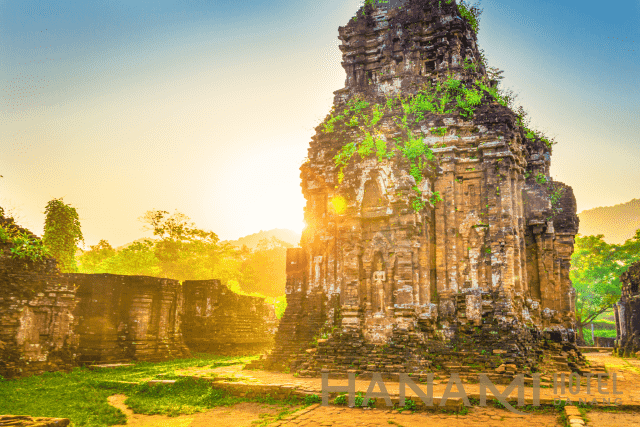
Location
My Son Sanctuary is a well-known attraction located approximately 70 kilometers from Da Nang. This is a location in Quang Nam’s Duy Phu commune, Duy Xuyen district. Once upon a time, My Son Sanctuary was forgotten for a long time. This location was not rediscovered until 1885. My Son Sanctuary was designated a UNESCO World Heritage Site in 1999, and is regarded as a symbol of Asian civilization. Today, with its distinctive architectural features and cultural values hidden in every detail, this location attracts a large number of domestic and foreign tourists who come to learn about the meanings of ancient cultural values.
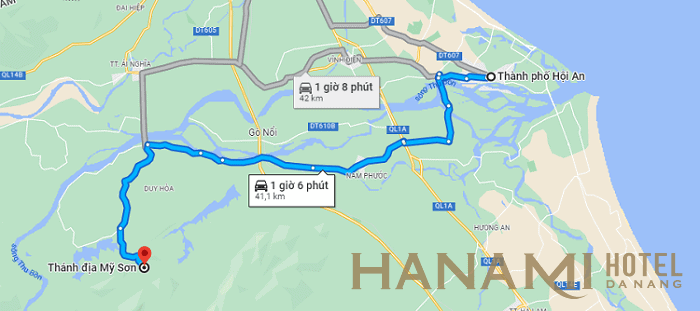
My Son Sanctuary is situated in a 2 km wide valley surrounded by hills and mountains. In the past, this was the location for sacrifices, as well as the mausoleum of the Champa dynasties’ kings and mandarins. It might be claimed that the items that remain today are extremely valuable. Aside from their cultural and tourism value, these are also important archaeological documents for learning about the old days.
How to get to My Son Sanctuary
Visitors can come here by motorbike, car, etc. The route is also pretty easy, so it doesn’t take a lot of time to get there. Those who enjoy exploring and backpacking might choose to go by motorbike so that they can immerse themselves in nature and view the most spectacular mountain scenery on both sides of the route. The drive from Da Nang to My Son Sanctuary is filled with breathtaking scenery that will make everyone’s voyage of discovery more meaningful and appealing.
Bus from Da Nang to My Son: Route 06 from Da Nang – My Son, departing from Da Nang city center bus station to My Son with a distance of 60km.
Reference operating hours: 5:30 a.m. to 17 p.m. daily, with a 30-minute trip schedule.
The reference ticket price ranges from 8,000 to 30,000 VND/way depending on the visitor’s itinerary.
Personal vehicles: Take Highway 1 to Nam Phuoc town for about 39 kilometers, then take Road 537 west for about 9 kilometers to Tra Kieu. From Tra Kieu, travel approximately 12 kilometers to the crossroads, turn left, follow the signboard for another 9 kilometers, and arrive at My Son. To get to the My Son sacred site, you must travel another 5 minutes by mountain road and then walk down the rocky road to get there.
Entrance fee & Opening hours
Entrance fee: 150,000 VND (including the fees to My Son Sanctuary and the Champa Museum). This price applies only to self-guided visits to My Son, without any tour guide service. It includes a 2-kilometer-long electric car ride to My Son’s center and art performance areas.
Opening hours: 6:30 am – 5:30 pm (every day, including holidays and Tet)
The ideal time to visit My Son Sanctuary
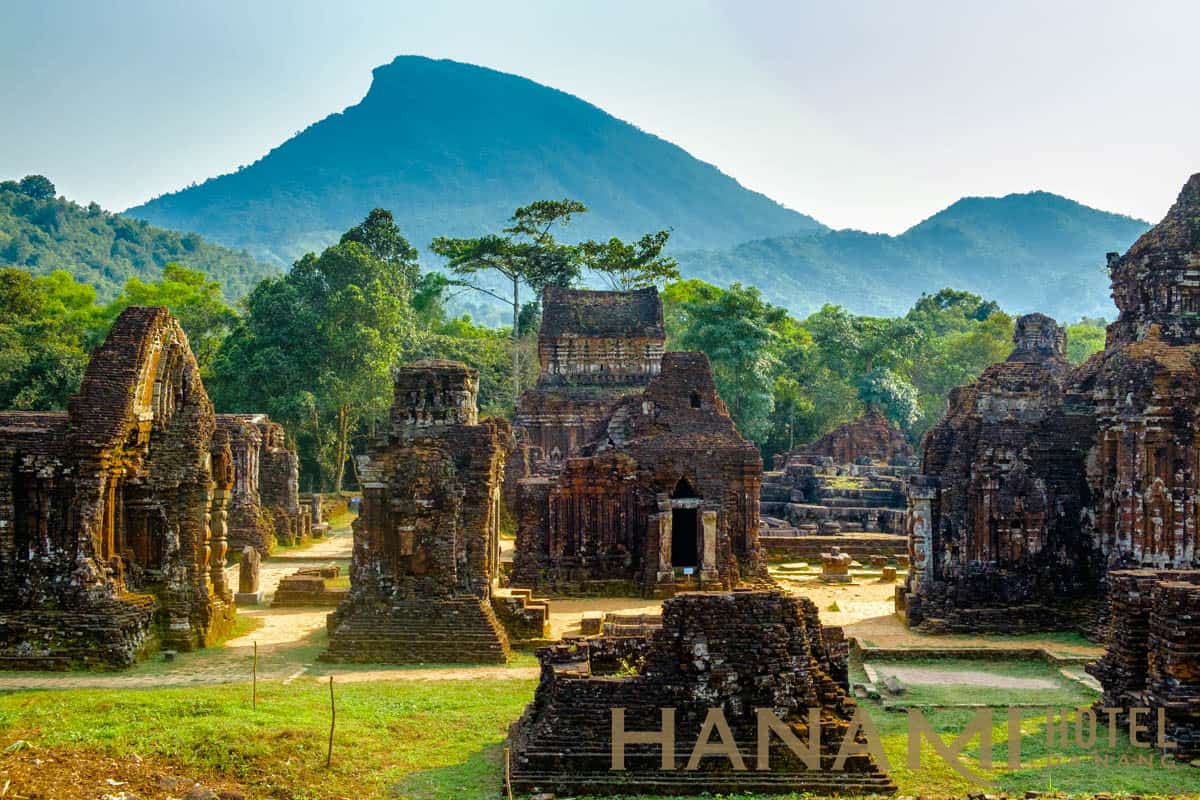
Quang Nam has 2 seasons: rainy season (September to December) and the dry season (February to August). The best time to visit My Son Sanctuary is usually from February to April. Although the weather will be cool and not hot at this time, you should still pack umbrellas, light coats, and sunscreen.
My Son Sanctuary: Ruins from the Champa Empire
The My Son Sanctuary is a historical complex with numerous profound cultural values, and it is also a testimony bearing the mark of a lengthy past. The My Son Sanctuary contains around 70 temples and towers of various architectural styles. Each style depicts a different historical period in the Champa kingdom at the time. The architectural style here is classified into six types: nostalgia style, Hoa Lai style, Dong Duong style, My Son style, PoNagar style, and Binh Dinh style.
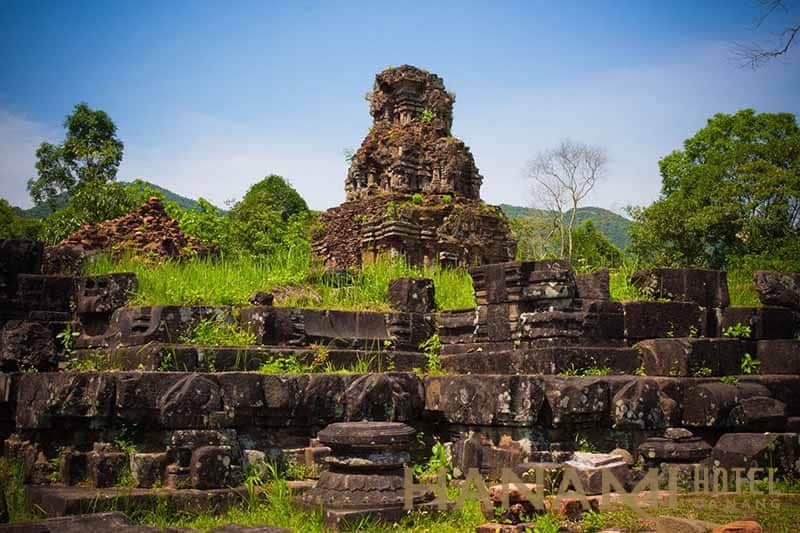
The majority of the sculptures and architectural creations in My Son are influenced by Hindu culture. One of the most striking aspects of Cham art is its strong character, which depicts the great vitality of individuals with a flexible spirit who are occasionally cheerful and other times contemplative.
Ancient Cham architecture
The masterpiece of the My Son Sanctuary carries the cultural marks of Champa architecture as well as Southeast Asian architecture. Cham towers are all pyramidal. The reason for this is the symbolism of Mount Meru, which is considered by Hindus to be the home of the Hindu gods.
According to the law of nature, the direction of the rising sun is west, so the gates are built toward the west to catch the sun. The decorative motifs in My Son Sanctuary are all carved in sandstone and depict creatures with sharp teeth and lengthy trunks, with the meaning of guarding the wall. Each epoch has its own distinct cultural mark that expresses the cultural ideals of that time period.
Overall monument
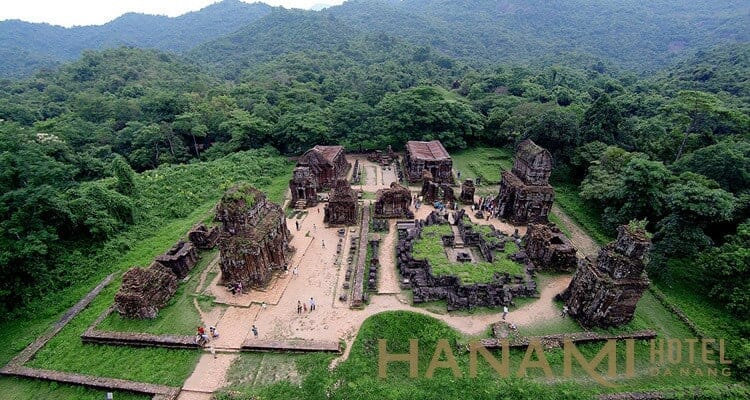
Overall, the My Son relic is made up of two hills that face one another, and the stream branches have created natural boundaries that easily split the zones into four zones A, B, C, and D. A massive Linga – Yoni set, a sign of cultural affluence, can be found inside the main tower of My Son Sanctuary. On each story, there are two doors with elaborate patterns on both sides.
Highlights
Time has gone by, and the conflict has wreaked havoc on this place, but what remains carries the mystery beauty, the unique architecture, and the distinct imprints of Champa culture. This distinction has enticed many travelers to visit. Admission tickets will be free for youngsters under the age of 15. All of the guides here are locals who are friendly, enthusiastic, and extremely hospitable. And the special thing is that they always have a strong sense of national pride.
Discover Champa Culture
My Son Sanctuary not only has its own individual architectural marks, but it also has incredibly distinct Cham cultural and spiritual values. Cham dances are soft, flexible, one-of-a-kind, and appealing. This location also offers a variety of other unique artistic activities to guests, such as folk performing arts, fire-biting dances, worship dances, and so on. It will undoubtedly satisfy those who visit and experience this well-known tourist site.
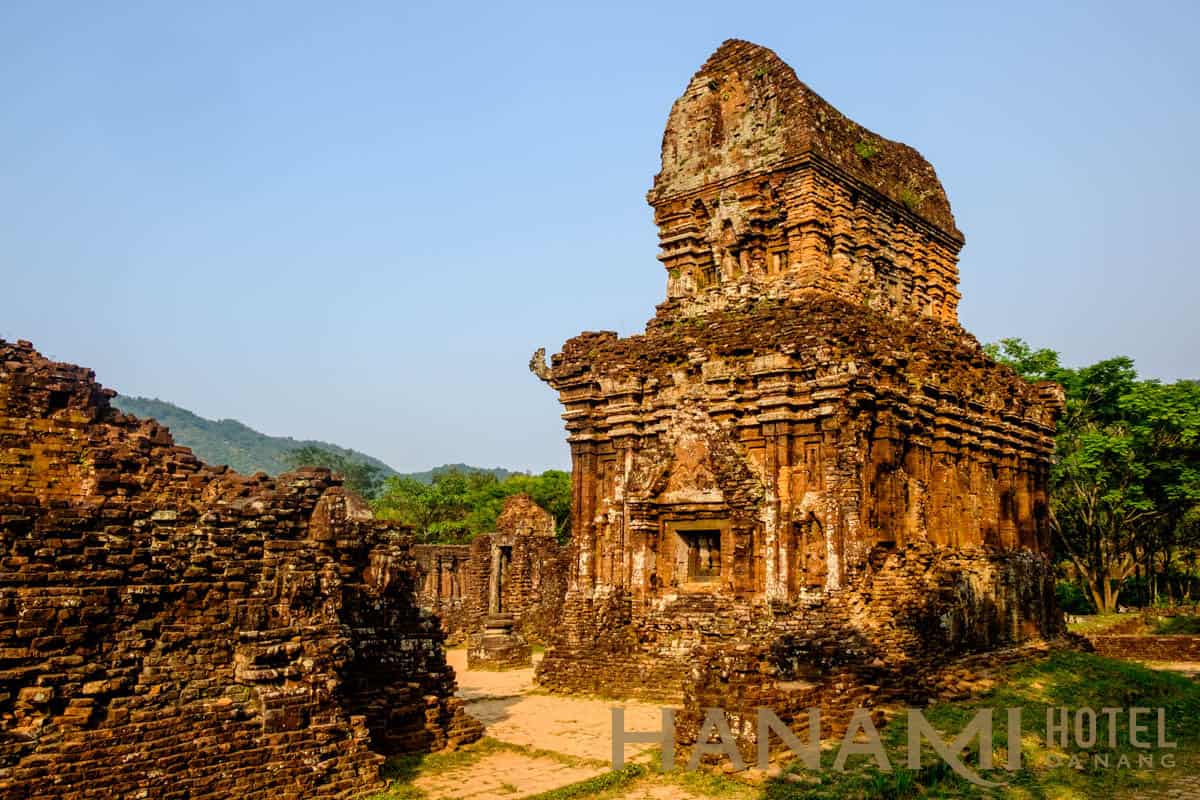
This is a perfect site for those who want to snap images and live virtually since the area here is secretive, intriguing, but also equally poetic and appealing. Those aspects will undoubtedly result in captivating photographs.
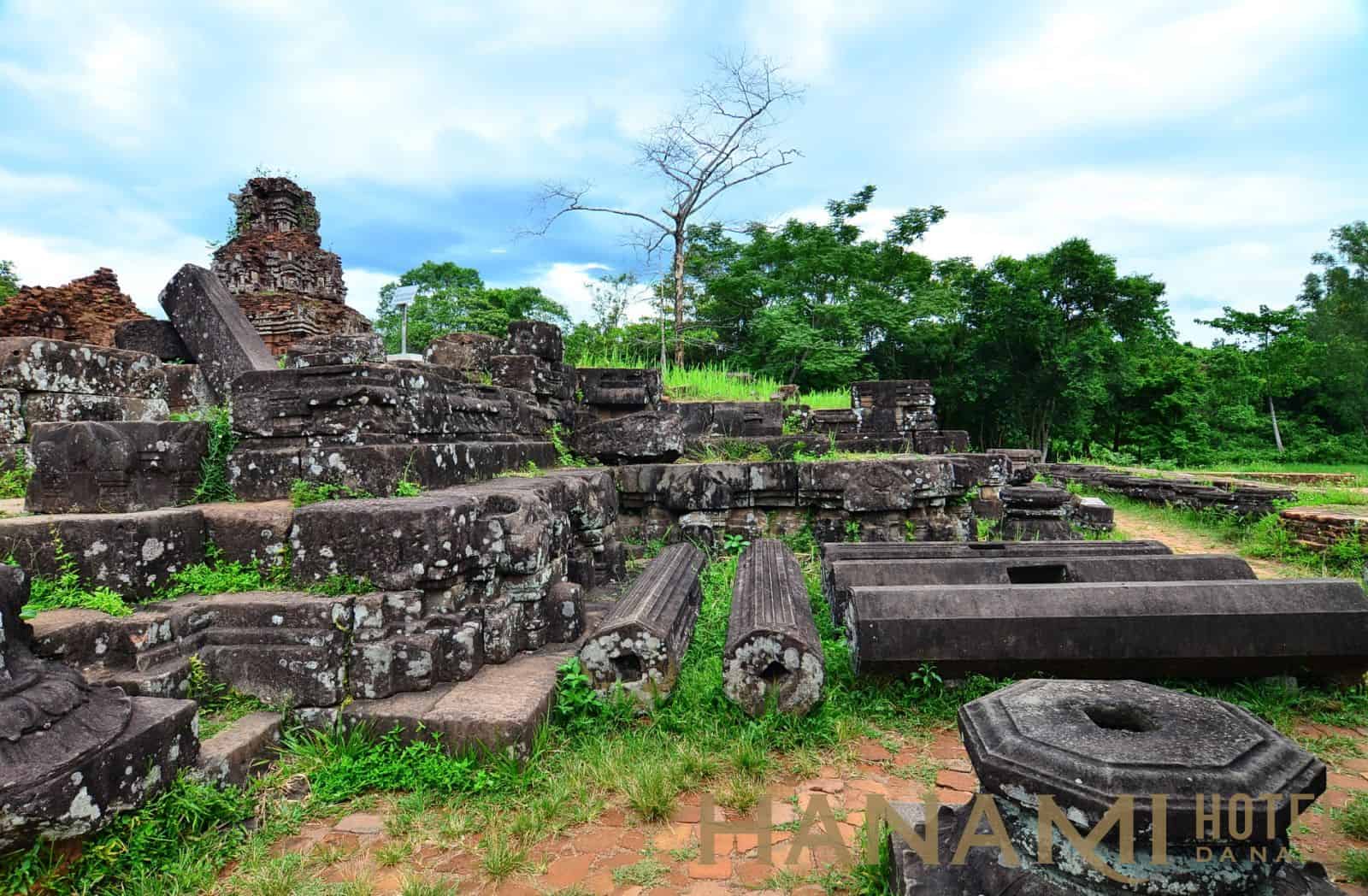
Aside from My Son Sanctuary, there are many more notable attractions that many people visit, such as Tra Kieu Church, the Museum of Sa Huynh and Champa Culture, and so on.
In addition to seeing, learning about culture, and experiencing the dances of the flexible Cham females. Visitors can taste exceptionally excellent specialty foods steeped in Cham culinary culture. Rice dumpling cake, Tam Ky chicken rice, Quang Nam green eel porridge, Quang noodles, and so forth are examples of these foods.
Kate Festival
One piece of advice for visitors to My Son Sanctuary is to go while the Kate festival is taking place; your journey will undoubtedly be richer and more fulfilling. Because many deeply significant customs and rituals that are recreated specifically for the festival, such as costumes, a palanquin procession, a water and Katte procession, cultural exchanges, performances of Cham dance by talented artists, Cham ethnic musical instruments, etc., will be available for you to see firsthand throughout the festival.
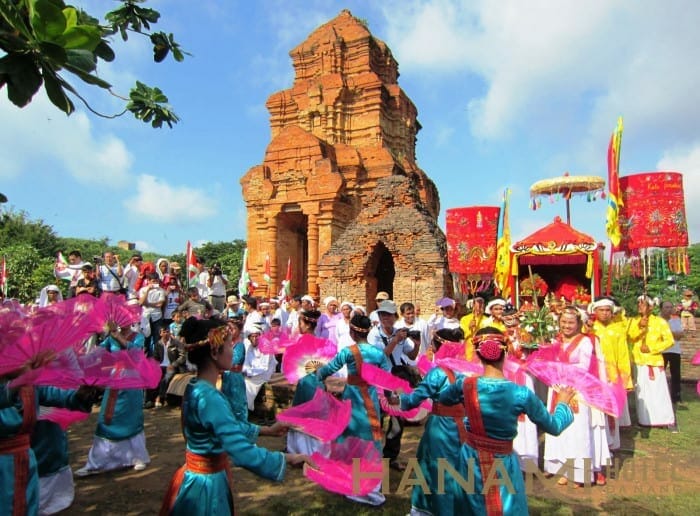
The modern Cham people celebrate the Kate festival, or Mbang Kate, for three days in early October. It is the Cham people’s most important event for commemorating their heroes and late-lamented families. This festival also serves as the largest gathering of the locals, allowing them to share their joy and to wish each other good fortune.
Festivals are held as both an occasion for people to gather together, an opportunity for visitors to learn about Champa culture, as well as a way to preserve and promote the unique cultural values.
The thousand-year-old road in My Son Sanctuary
The thousand-year-old road in My Son Sanctuary is a landmark that visitors should not miss when visiting. During the excavation and restoration of this artifact, Indian scientists uncovered this road. This road is up to 8 meters wide, and according to ancient documents recorded, this path was used by ancient rulers to travel to the central temple and tower to make sacrifices and perform important rites.
Experts must be amazed by the complex and ingenious lines that the ancients meticulously crafted to have a road full of art after being dug at a burial depth of more than one meter. The road is made primarily of terracotta, with unique additives and adhesion that have yet to be determined. The ancients must have thought it was exceedingly clever and brilliant to be able to produce such one-of-a-kind architectural works.
Apsara dance
The complex of My Son Sanctuary is distinguished not only by architectural characteristics imbued with Champa culture, old dances that pique the interest of visitors, or cultural imprints that have yet to be described, but also by the ancient relics of a long-lost culture. This location not only has cultural value, but it also has historical, architectural, art, and sculpture values, all of which have combined to produce a one-of-a-kind My Son Sanctuary that visitors should not miss.
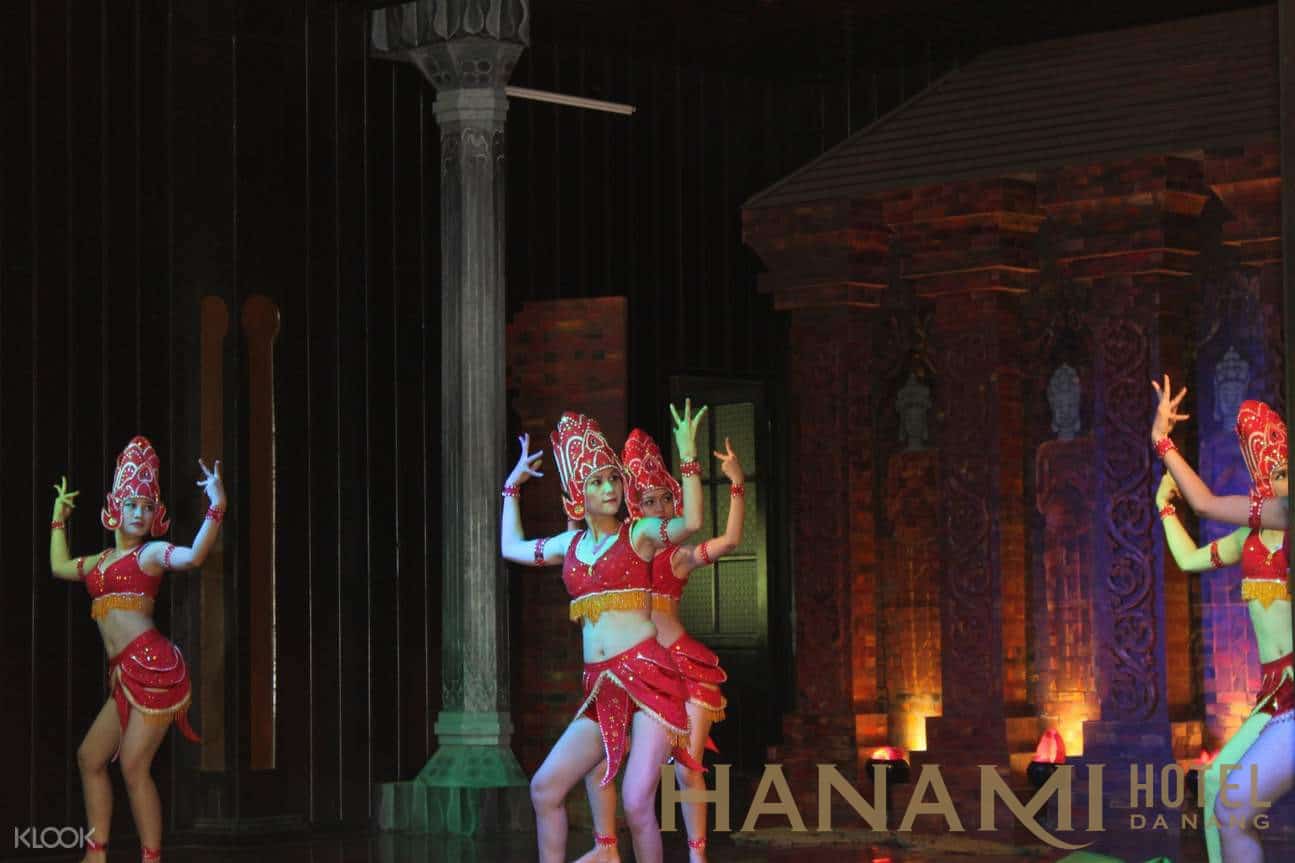
Local dancers perform the dances, which vary from Cham’s iconic Shiva and Aspara dances that date back hundreds of years, to joyful fan dances and water dances. Each dance is unique, creating a gleaming and fanciful Champa cultural space. It is an awe-inspiring experience: to enjoy the local dancer’s flexibility and attractiveness while listening to folk music in a sacred space.
Only about 70 kilometers from Da Nang city, My Son Sanctuary is a location that should not be overlooked when looking for Da Nang tourism attractions.
Treat your taste buds with the specialties of My Son Sanctuary
Cau Mong Roasted Veal
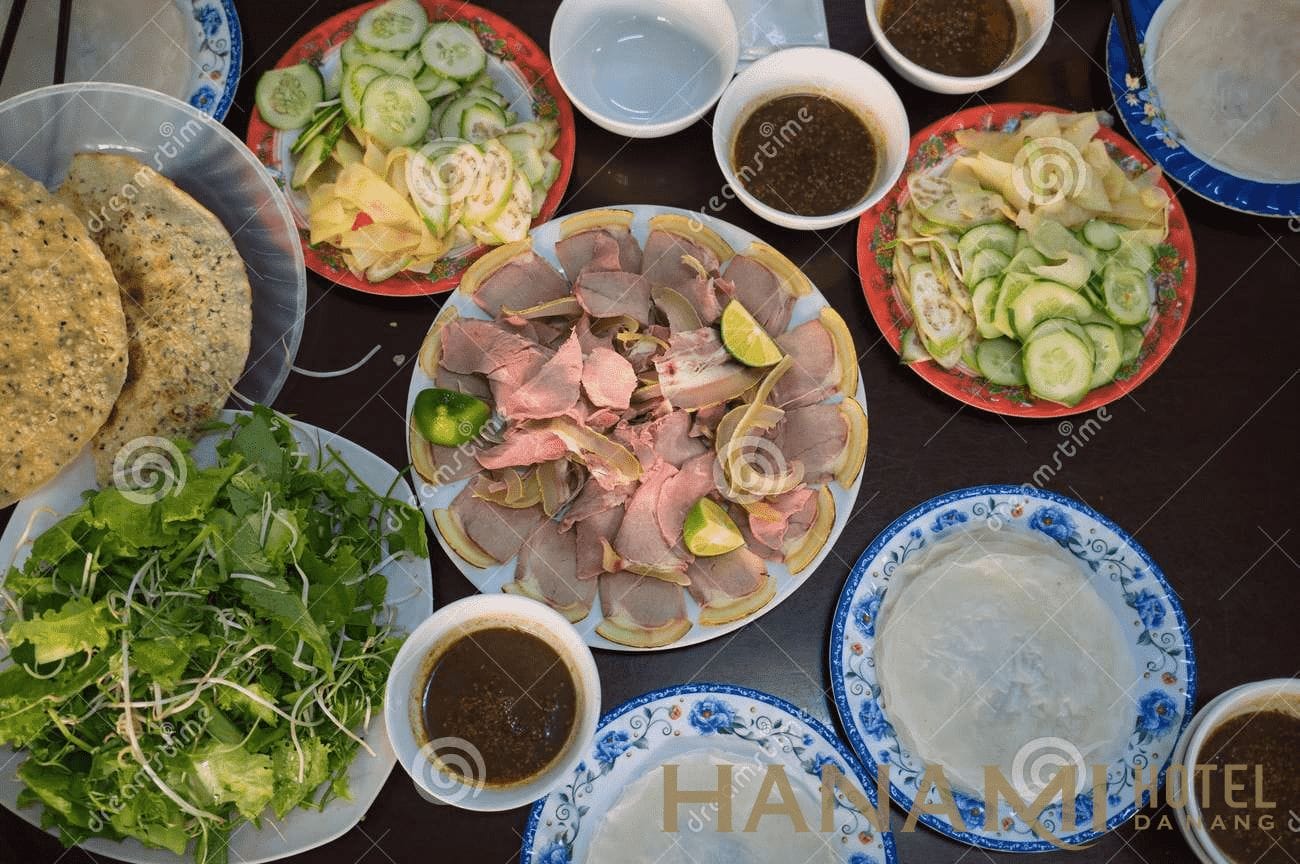
Cau Mong roasted veal is a dish made from young veal roasted on a charcoal fire. The meat is sliced into medium and thin slices. The Cau Mong veal meat is served with raw vegetables of all kinds from the countryside, including raw bean sprouts, slices of seeded-banana and sour star fruits, and many kinds of herbs. The meat is rolled with small, thin, long rice cake and dipped with fish sauce made from anchovies added with grinded chili, garlic and ginger, roasted sesame and lemon, etc.
For truly and delicious Cau Mong roasted veal meat, you should go to Dien Ban to be served the sweet, chewy roasted veal with a cup of fragrant fish sauce.
Cau Mong roasted veal meat is recognized by the Vietnam Record Organization as one of the top 50 famous Vietnamese dishes.
- Address: Thanh Hoa Street, Tam Ky City
Phu Chiem Quang noodles
And once it comes to Quang noodle on the land of Quang Nam, it is highly recommended that visitors should not miss the chance to enjoy the true taste of this signature dish in Phu Chiem, an area in Triem Nam Village, Dien Phuong Commune in Dien Ban District that is claimed to be the birthplace of the noodle.
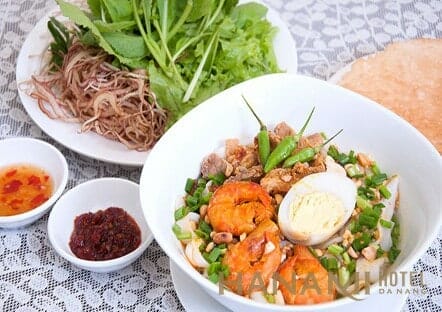
What makes a bowl of Quang noodle in Phu Chiem special is the broth, which takes a lot of effort to make. First of all, people boil peanuts and then grind them to extract milk, which is then mixed with the ground meat of paddy field crabs. After that, the mixture is cooked with shrimp that is roasted with salt and mixed with peanut oil for a while. The broth is then added with thit ba roi (fat and lean meat) and cooked for 15 more minutes.
Through generations, the delicious and typical taste of Phu Chiem Quang Noodles has been well-preserved with its fragrant and greasy broth, while the noodles are not too tough or soft. Therefore, it would be a worthy experience to enjoy the dish right in its hometown.
- Address: 6A Truong Minh Luong, Hoi An, Quang Nam
Crushed rice cracker with anchovy fish sauce (Banh Dap)
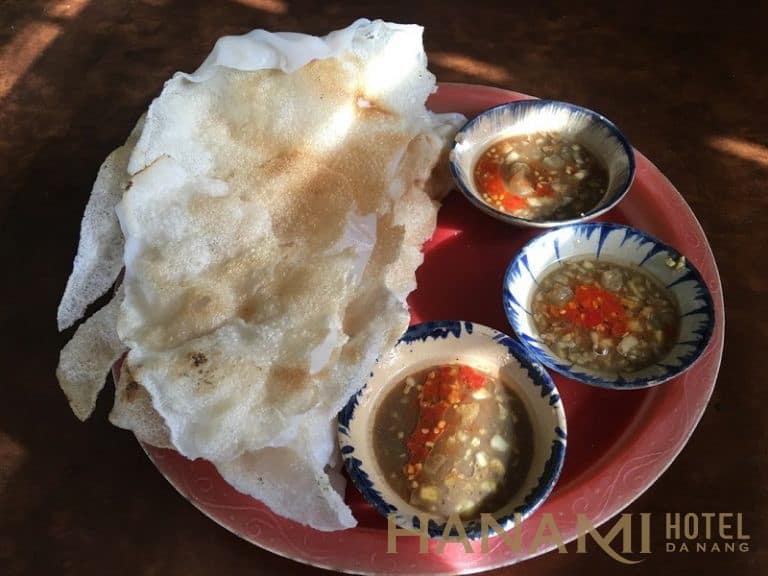
Originating from Quang Nam Province, “banh trang dap” (crushed rice crackers with anchovy fish sauce) has now become one of the most popular rustic specialty dishes in Da Nang.
To make this dish, a layer of thin steamed rice cake is placed over grilled rice paper with the addition of a little cooking oil and some thin slices of fried spring onions. The grilled rice paper is then swiftly folded in half.
This simple and cheap food is served with a small bowl of anchovy fish sauce mixed with garlic, chilli, lemon, sugar, a little oil, and some fried spring onions on top to give an amazing mixture of unique aftertastes!
Address:
- 679 Hai Ba Trung, City. Hoi An, Quang Nam
- Cam Nam Commune, City. Hoi An, Quang Nam
Water fern cake (Banh Beo)
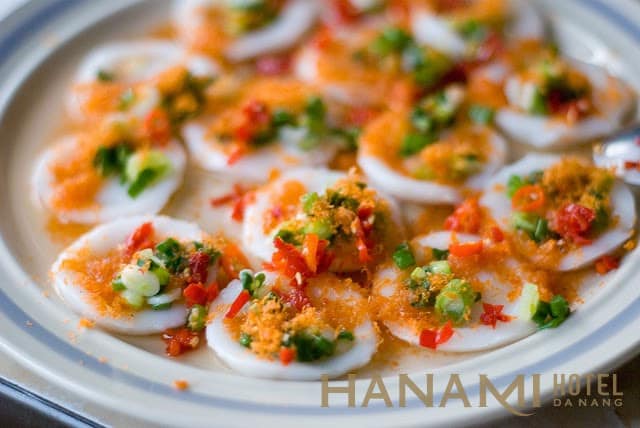
It is merely a thin steamed rice cake with its top stuffed with minced shrimp mingled with scallions, green bean paste, and crispy fried shallots. But with addictive sour and spicy sauce, an eye-catching color mixture of fish sauce, sugar, garlic, chili and fresh small shrimps, watery grease, the cake is certain to whet the appetite of anyone. The cake is not wrapped in leaves but served in a small condiment size bowl or stacked on a plate.
It is not surprising when guests smile with satisfaction after leaving a pile of more than 10 empty bowls but still crave for more. After a day of sightseeing, sitting in a small vendor stall, savoring sweet, spicy and refined flavor of Bèo cakes is really a great experience.
- Address: 2 Hoang Van Thu, Hoi An city, Quang Nam.
Vietnamese pancake (Banh Xeo)
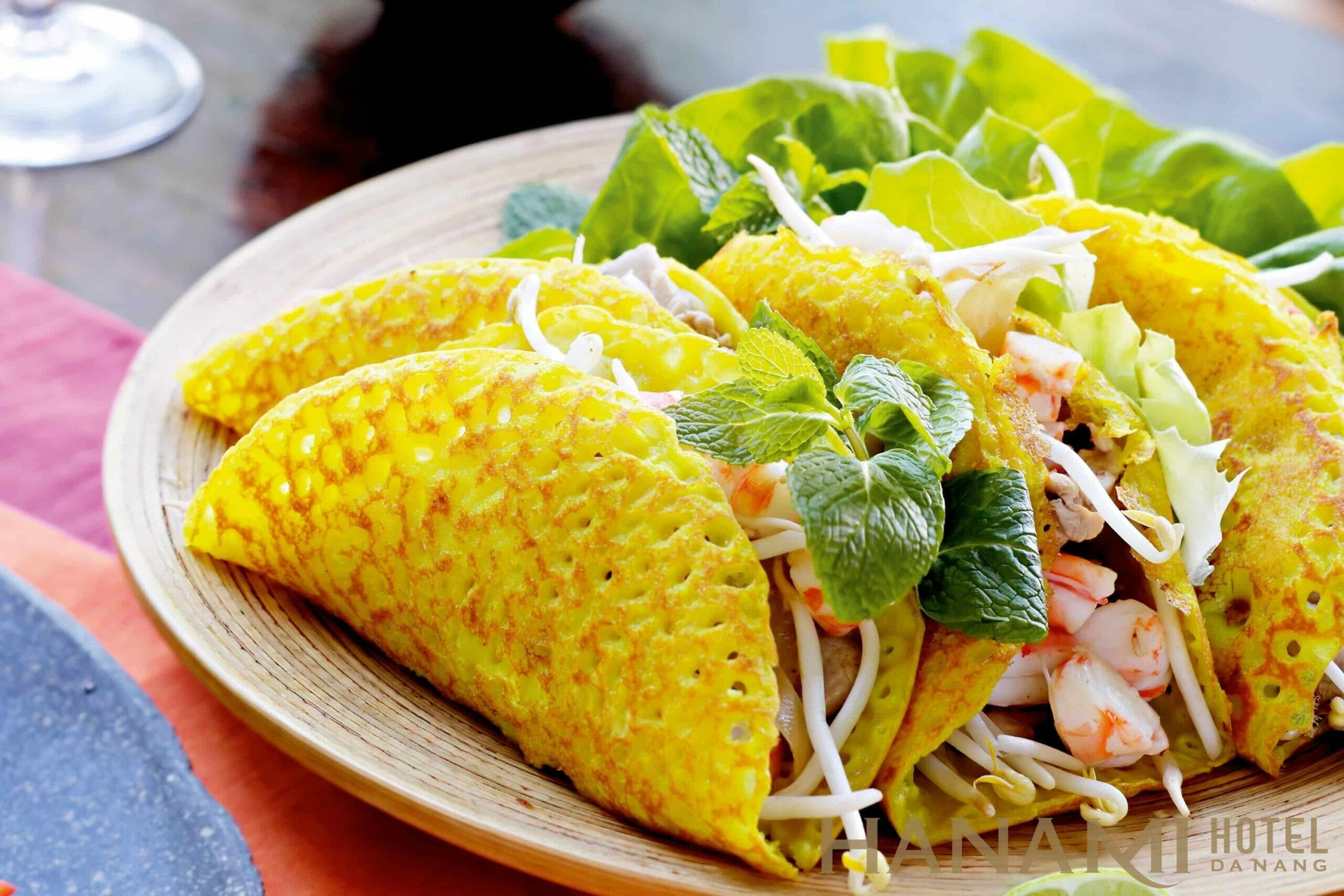
This “Vietnamese pancake” has a yellow outer layer and is filled with boiled pork strips, shrimp, bean sprouts and spring onion. Though some people might prefer to use chopsticks to directly eat bánh xèo, the best way to enjoy it is eating with your hands. First, take a piece of bánh xèo and put it on the rice paper. Add fresh vegetables that are always served with the dish (there’re a lot of vegetables to choose from, but lettuce, Vietnamese perilla, basil and bean sprouts are the most common) and roll them tightly. With each bite, don’t forget to dip the roll into the sauce.
right after the first bite, the impressive taste of crunchy crust, savory fillings, sweet and sour dipping sauce will definitely make you fall in love with this delicacy. Besides, the sauce is a perfect blend of spices (including fish sauce, sugar, lime juice, garlic and chili), while the herbs help eliminate the greasy taste.
- Address: Ai Nghia Bridge, Dai Loc, Quang Nam.
Tam Ky Rice Chicken
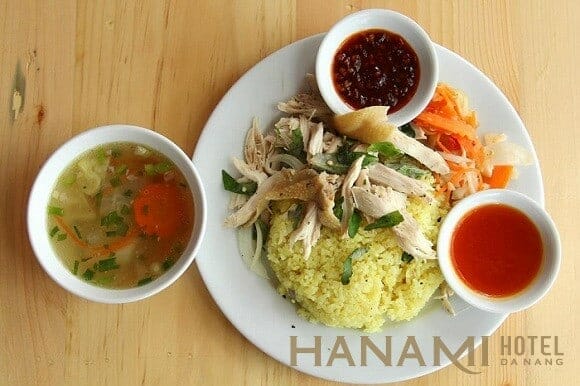
Together with grilled meat rolls and Quang noodles, Tam Ky chicken rice has become something of a ‘brand’ in the center of Quang Nam Province.
The locals use chicken boiling water to cook with rice, so the rice has yellow color. It is not easy to cook an exemplary chicken rice plate. Tourists can get to visit the master chefs in Quang Nam’s street-side eateries.
The cooked rice is soft and glutinous, not dry and pasty. When the pot cover is opened the fragrant and aromatic smell of rice should permeate. The chicken and pandan leaves together create their own unique flavor for Tam Ky chicken rice.
The rice is now ready to be served with some shredded chicken, blended with hot mint, lemon leaves, pepper and salt. It can be served along with fish sauce mixed with garlic and chili. Without a doubt, it is an incredibly tasty dish.
- Address: No. 576 Phan Chu Trinh, Chau Hoa Huong, Tam Ky, Quang Nam
Quang Nam green eel porridge
When having the opportunity to come to Quang Nam, it is difficult for tourists to resist the rustic specialty dish that has existed for many generations, which is green eel porridge or rice porridge. Because people here eat eel porridge with broccoli, they call it green eel porridge. This dish is cooked with si rice, a local variety of rice from a very long time ago, flexible, fragrant, and has a very unique sweet taste.
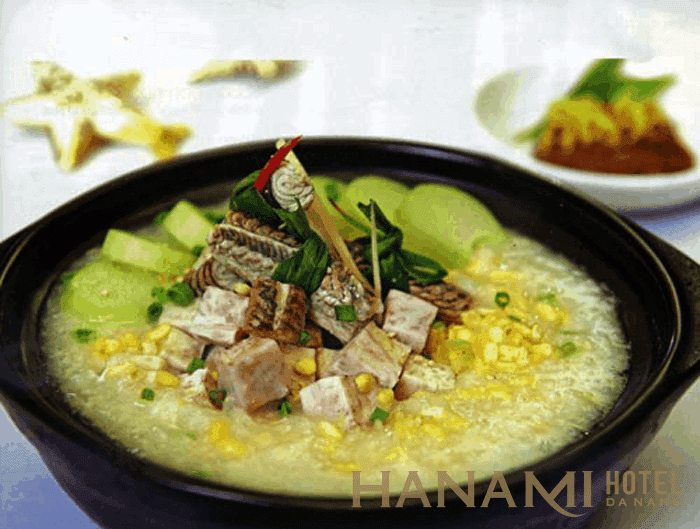
When eating, the people of Quang have two ways. Some people put cabbage and vegetables, broken rice paper into a bowl of porridge while blowing and scooping each spoon into their mouths. Others slowly put each stalk of broccoli into each spoon of porridge to taste the spicy taste of broccoli, the fleshy taste of beans, the fatty but fragrant taste of eel, and the sweet and faint scent of homegrown rice. But all of them ate hot and occasionally took a bite of a green chili, making everyone sitting near them want to eat.
- Address: No.162 Hung Vuong, An My Ward, Tam Ky, Quang Nam.
Some tips when visiting My Son Sanctuary
To make the vacation go as well as possible, in addition to planning fun and eating correctly, keep the following points in mind:
- The best time to visit the My Son Sanctuary is from February to April.
- The entrance fee to the relic is 100,000 VND for Vietnamese visitors and 150,000 VND for foreign visitors. This ticket price includes: sightseeing tickets, tram rides, and the opportunity to enjoy cultural performances. Tickets can be purchased directly at the monument’s entrance.
- My Son Sanctuary does not support worshiping and burning incense activities. Therefore, visitors should avoid these activities.
- If you plan to visit other destinations around the relic, you should book the entrance ticket in advance to avoid the ticket shortage, affecting the trip schedule.
If you’re still looking for tourist attractions in Da Nang, visit My Son Sanctuary in Quang Nam province, which will undoubtedly make your trip more meaningful and complete. Hanami Hotel has provided remarkable and useful information on the My Son Sanctuary, a well-known location in Vietnam that has been designated as a UNESCO World Heritage Site. We wish you wonderful tours with friends and family in My Son Sanctuary.
Về tác giả:
Chúng tôi không kiếm lợi nhuận từ nội dung đăng tải. Các bài viết đều được biên soạn và kiểm duyệt bởi đội ngũ tác giả và biên tập viên của công ty TNHH du lịch khách sạn Hana. Xem thêm: về tác giả

